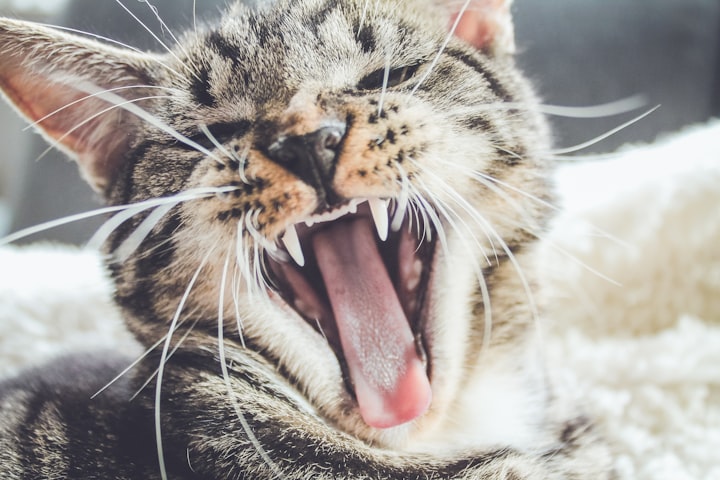Why cats become so aggressive?
Understanding the Causes of Aggression in Cats

Cats, often regarded as independent and aloof creatures, can display aggressive behavior that may be perplexing to their owners. While aggression in cats is not uncommon, it is essential to explore the underlying reasons behind this behavior. By delving into the various factors contributing to feline aggression, we can gain a better understanding of our feline companions and implement strategies to address and manage their aggressive tendencies.
Territorial Instincts:
One primary reason for aggression in cats is their strong territorial instincts. Cats are inherently territorial animals, and any perceived threat to their territory can trigger aggressive responses. This behavior is particularly evident in multi-cat households, where conflicts may arise over territory, resources, or dominance.
Fear and Anxiety:
Cats may become aggressive when they feel threatened or anxious. Fearful situations, such as encountering unfamiliar people, animals, or environments, can provoke defensive aggression. Understanding and minimizing sources of anxiety in a cat's environment can significantly reduce aggressive behaviors.
Pain or Medical Issues:
Aggression in cats can be a manifestation of pain or discomfort. Health problems, such as dental issues, arthritis, or internal pain, may cause a cat to lash out defensively. Regular veterinary check-ups are crucial for identifying and addressing any potential medical causes of aggression.
Socialization and Early Experiences:
The early socialization and experiences of a cat play a significant role in shaping its behavior. Cats that were not adequately socialized as kittens or had negative interactions with humans or other animals during their formative weeks may exhibit aggression as a learned response to perceived threats.
Play Aggression:
Play aggression is a common behavior in young cats. Kittens engage in rough play to develop their hunting and defensive skills. However, if not properly guided, this playfulness can escalate into aggressive behavior. Providing appropriate outlets for play and using interactive toys can redirect this energy in a positive way.
Lack of Stimulation and Enrichment:
Boredom and a lack of mental and physical stimulation can lead to aggression in cats. Indoor cats, in particular, may become frustrated and agitated without sufficient environmental enrichment. Providing toys, scratching posts, and interactive playtime can help alleviate boredom-related aggression.
Hormonal Influences:
Hormonal changes, such as those related to breeding or intact animals, can contribute to aggressive behavior. Spaying or neutering can help manage hormonal-driven aggression and prevent unwanted behaviors associated with mating instincts.
Environmental Stressors:
Cats are highly sensitive to changes in their environment. Moving to a new home, rearranging furniture, or introducing new pets can be stressful for felines, leading to defensive aggression. Gradual introductions to changes, providing safe spaces, and maintaining a consistent routine can help alleviate environmental stressors.
Redirected Aggression:
Sometimes, cats may redirect their aggression towards a person or another pet if they are agitated or overstimulated by an external factor. Understanding the triggers for redirected aggression, such as seeing a neighborhood cat through a window, allows owners to manage these situations and prevent aggressive outbursts.
Lack of Social Structure:
Cats are not pack animals like dogs, but they do thrive on social structures within their living environment. The absence of a clear social structure or the introduction of a new pet without proper integration can lead to conflicts and aggression. Providing separate resources for each cat and facilitating gradual introductions can help establish a harmonious social order.
Punishment and Negative Reinforcement:
Inconsistent or harsh punishment can contribute to aggression in cats. Cats do not respond well to punishment, and negative reinforcement may lead to defensive or fear-based aggression. Positive reinforcement techniques, such as rewarding good behavior, are more effective in shaping desirable conduct in cats.
Lack of Training and Boundaries:
Cats benefit from positive reinforcement training to establish boundaries and acceptable behavior. Without clear guidelines, cats may resort to aggression to communicate their needs or frustrations. Training sessions, coupled with rewards for positive behavior, can contribute to a more obedient and less aggressive cat.
Understanding the multifaceted nature of feline aggression requires a holistic approach that considers various factors influencing a cat's behavior. Owners play a crucial role in creating a conducive environment that minimizes stressors, provides mental and physical stimulation, and establishes clear social structures. Regular veterinary check-ups, positive reinforcement training, and proactive management of potential triggers contribute to a healthier and happier feline-human relationship.
In summary, while aggression in cats may be challenging, it is often a symptom of underlying issues that can be addressed with patience, understanding, and appropriate interventions. By recognizing the diverse factors contributing to feline aggression, owners can work towards fostering a secure and contented atmosphere for their cats, promoting overall well-being and reducing the likelihood of aggressive behavior.
About the Creator
JENNA HERNANDEZ
I am an article writer who conducts research and writes well-structured, informative articles on a wide range of topics. My work involves gathering extensive information, organizing ideas logically, and ensuring clear, error-free language.






Comments
There are no comments for this story
Be the first to respond and start the conversation.